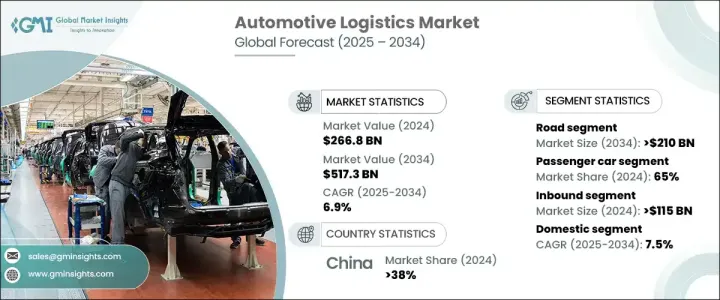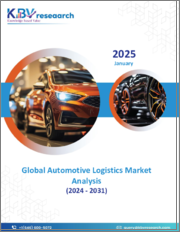
|
시장보고서
상품코드
1685142
자동차 물류 시장 기회, 성장 촉진요인, 산업 동향 분석, 예측(2025-2034년)Automotive Logistics Market Opportunity, Growth Drivers, Industry Trend Analysis, and Forecast 2025 - 2034 |
||||||
세계의 자동차 물류 시장 규모는 2024년에 2,668억 달러로 평가되었고, 2025년부터 2034년에 걸쳐 CAGR 6.9%를 나타낼 것으로 예측됩니다.
이 산업은 자동차 등록 대수 증가와 자동차 부품의 조직 창고 보관에 대한 요구 증가에 따라 확대되고 있습니다. 세계 무역과 자동차 생산이 급증하고 있는 가운데 효율적인 배송 솔루션이 중요해지고 있습니다. 지속가능한 운송에 대한 관심 증가는 시장을 형성하고 있으며, 기업은 친환경 물류를 지원하기 위해 저 배출 가스 차량에 투자하고 있습니다. 전기자동차 수요도 물류 서비스를 재구성하고 있으며, 전기자동차와 배터리의 운송에 특화된 솔루션이 필요합니다. 제어된 환경을 유지하고 배터리 물류에 고급 운송 차량을 사용하는 것은 시장 경쟁력을 높이는 주요 요인입니다.

시장은 운송 수단별로 도로, 철도, 해상, 항공으로 구분됩니다. 2024년에는 도로 수송 분야가 42% 시장 점유율을 차지했고, 2034년에는 2,100억 달러 이상에 달할 것으로 예상되고 있습니다. 도로 인프라에 대한 투자는 운송 시간과 비용을 줄임으로써 효율성을 향상시키고 있습니다. 첨단 물류 네트워크는 차량 및 부품의 신속한 배송을 가능하게 하고 공급망과 마지막 마일 물류를 강화합니다. 도로화물은 직통 경로와 고속 운송의 우위성으로 인해 여전히 압도적 인 힘을 자랑합니다. 또한 배기 가스 규제의 강화로 전기 트럭과 지속 가능한 물류의 도입이 추진되어 환경에 미치는 영향을 줄이고 업계의 성장을 지원하고 있습니다.
| 시장 범위 | |
|---|---|
| 시작 연도 | 2024년 |
| 예측 연도 | 2025-2034년 |
| 시작 금액 | 2,668억 달러 |
| 예측 금액 | 5,173억 달러 |
| CAGR | 6.9% |
시장은 차량별로 승용차와 상용차로 나뉘며, 2024년 시장 점유율은 승용차가 65%를 차지했습니다. 세계 자동차 생산량과 등록량이 증가함에 따라 자동차 부품의 효율적인 운송, 보관 및 유통에 대한 필요성이 증가하고 있습니다. 실시간 추적 및 자동 재고 시스템과 같은 물류 기술의 통합은 공급망의 효율성을 높입니다. 이러한 발전으로 인벤토리 관리 최적화, 경로 계획 개선, 운영 비용 절감, 물류 수익성 및 확장성이 높아지고 있습니다.
서비스 유형별로는 인바운드 물류, 아웃바운드 물류, 리버스, 애프터마켓 물류가 있습니다. 2024년에는 인바운드 물류 부문이 우위를 차지하여 1,150억 달러 이상을 창출했습니다. 세계 자동차 생산 규모의 확대로 부품과 원재료의 효율적인 운송에 대한 수요가 높아지고 있습니다. 정교한 인바운드 물류 솔루션은 완벽한 제조 작업을 보장합니다. 세계 공급망의 통합은 더욱 효율성을 높이고 비용을 낮추고 인바운드 물류 속도를 향상시키고 시장 확대를 지원합니다.
유통분야는 국내물류와 국제물류로 분류되며 국내물류는 예측기간 동안 CAGR 7.5%를 나타낼 것으로 예측됩니다. 정부 정책, 세제 우대 조치, 공급망 강화로 국내물류 네트워크가 강화되고 있습니다. 자동차 산업의 전자상거래와 소비자 직접 판매 증가는 지역 밀착형 물류 서비스 수요를 더욱 밀어 올리고 있습니다. 소비자는 현재 택배 옵션이 있는 자동차를 온라인으로 구매하기를 선호하고 있으며 최적화된 물류 네트워크가 필요합니다.
중국은 세계의 자동차 물류 시장을 선도하고 2024년에는 점유율 전체의 38% 이상을 차지했습니다. 세계 최대의 자동차 생산 거점으로서, 동국의 견조한 생산·수출 활동이 물류 수요를 견인하고 있습니다. 교통 허브의 확대와 도로망의 정비 등 정부의 이니셔티브와 인프라의 개선으로 중국은 업계의 주요 기업로서의 지위를 굳히고 있습니다.
목차
제1장 조사 방법과 조사 범위
- 조사 디자인
- 조사 접근
- 데이터 수집 방법
- 기본 추정과 계산
- 기준연도의 산출
- 시장추계의 주요 동향
- 예측 모델
- 1차 조사와 검증
- 1차 정보
- 데이터 마이닝 소스
- 시장 범위와 정의
제2장 주요 요약
제3장 업계 인사이트
- 생태계 분석
- 부품 제공업체
- 제조업체
- 서비스 제공업체
- 기술 제공업체
- 최종 사용자
- 이익률 분석
- 공급업체 상황
- 물류의 운영 지표
- 기술 및 혁신 환경
- 특허 분석
- 규제 상황
- 영향요인
- 성장 촉진요인
- 실시간 추적 및 모니터링 시스템 통합
- 국제 물류 수요 증가
- 전기자동차(EV) 시장의 성장
- 부품 및 부속품의 운송 수요 증가
- 업계의 잠재적 위험 및 과제
- 연료 가격 변동으로 인한 운영 비용 상승
- 성장 촉진요인
- 성장 가능성 분석
- Porter's Five Forces 분석
- PESTEL 분석
제4장 경쟁 구도
- 서론
- 기업 점유율 분석
- 경쟁 포지셔닝 매트릭스
- 전략 전망 매트릭스
제5장 시장 추계·예측 : 서비스별(2021-2034년)
- 주요 동향
- 인바운드
- 아웃바운드
- 리버스
- 애프터마켓
제6장 시장 추계·예측 : 운송별(2021-2034년)
- 주요 동향
- 도로
- 철도
- 해상
- 항공
제7장 시장 추계·예측 : 차량별(2021-2034년)
- 주요 동향
- 승용차
- 해치백
- 세단
- SUV
- 기타
- 상용차
- 소형차
- 중형차
- 대형차
제8장 시장 추계·예측 : 유통별(2021-2034년)
- 주요 동향
- 국내
- 해외
제9장 시장 추계·예측 : 활동별(2021-2034년)
- 주요 동향
- 창고
- 운송
제10장 시장 추계·예측 : 지역별(2021-2034년)
- 주요 동향
- 북미
- 미국
- 캐나다
- 유럽
- 영국
- 독일
- 프랑스
- 이탈리아
- 스페인
- 러시아
- 북유럽
- 아시아태평양
- 중국
- 인도
- 일본
- 호주
- 한국
- 동남아시아
- 라틴아메리카
- 브라질
- 멕시코
- 아르헨티나
- 중동 및 아프리카
- UAE
- 남아프리카
- 사우디아라비아
제11장 기업 프로파일
- Agility Logistics
- APL Logistics
- BLG Logistics Group
- CEVA Logistics
- DB Schenker
- DHL Supply Chain
- DSV
- Expeditors International
- FedEx Logistics
- Geodis
- Hellmann Worldwide Logistics
- Imperial Logistics
- Kuehne Nagel
- Nippon Express
- Panalpina
- Penske Logistics
- Ryder System
- SNCF Logistics
- UPS Supply Chain Solutions
- XPO Logistics
The Global Automotive Logistics Market was valued at USD 266.8 billion in 2024 and is projected to grow at a CAGR of 6.9% from 2025 to 2034. The industry is expanding due to increasing vehicle registrations and the rising need for organized warehousing of automotive components. As global trade and vehicle production continues to surge, efficient dispatch solutions are becoming critical. A growing focus on sustainable transportation is shaping the market, with companies investing in low-emission fleets to support eco-friendly logistics. The demand for electric vehicles is also reshaping logistics services, requiring specialized solutions for transporting EVs and their batteries. Maintaining controlled environments and using advanced transportation vehicles for battery logistics are key factors enhancing competitiveness in the market.

The market is segmented by transportation into road, rail, sea, and air. In 2024, the road transport segment held a 42% market share and is expected to surpass USD 210 billion by 2034. Investments in road infrastructure are improving efficiency by reducing transportation time and costs. Advanced logistics networks are enabling faster vehicle and component deliveries, strengthening supply chains and last-mile distribution. Road freight remains a dominant force due to its direct routes and high-speed advantages. Additionally, stricter emission regulations are driving the adoption of electric trucks and sustainable logistics, reducing environmental impact and supporting industry growth.
| Market Scope | |
|---|---|
| Start Year | 2024 |
| Forecast Year | 2025-2034 |
| Start Value | $266.8 Billion |
| Forecast Value | $517.3 Billion |
| CAGR | 6.9% |
The market is divided by vehicle type into passenger cars and commercial vehicles, with passenger cars accounting for 65% of the market share in 2024. Increasing global vehicle production and registrations are fueling the need for efficient transportation, storage, and distribution of automotive parts. The integration of logistics technologies, such as real-time tracking and automated inventory systems, is enhancing supply chain efficiency. These advancements are optimizing inventory control, improving route planning, and reducing operational costs, making logistics more profitable and scalable.
By service type, the industry includes inbound, outbound, reverse, and aftermarket logistics. In 2024, the inbound logistics segment dominated, generating over USD 115 billion. The growing scale of global automotive production has heightened demand for efficient transportation of parts and raw materials. Sophisticated inbound logistics solutions are ensuring seamless manufacturing operations. Global supply chain integration is further improving efficiency and lowering costs, enhancing the speed of inbound logistics and supporting market expansion.
The distribution segment is categorized into domestic and international logistics, with domestic logistics projected to grow at a 7.5% CAGR during the forecast period. Government policies, tax incentives, and supply chain enhancements are strengthening domestic logistics networks. Increased e-commerce and direct-to-consumer sales in the automotive sector are further boosting demand for localized logistics services. Consumers now prefer purchasing vehicles online with home delivery options, necessitating optimized distribution networks.
China leads the global automotive logistics market, holding over 38% of the total share in 2024. As the world's largest automobile manufacturing hub, the country's robust production and export activities are driving logistics demand. Government initiatives and infrastructure improvements, including expanded transportation hubs and upgraded road systems, are solidifying China's position as a key player in the industry.
Table of Contents
Chapter 1 Methodology & Scope
- 1.1 Research design
- 1.1.1 Research approach
- 1.1.2 Data collection methods
- 1.2 Base estimates & calculations
- 1.2.1 Base year calculation
- 1.2.2 Key trends for market estimation
- 1.3 Forecast model
- 1.4 Primary research and validation
- 1.4.1 Primary sources
- 1.4.2 Data mining sources
- 1.5 Market scope & definition
Chapter 2 Executive Summary
- 2.1 Industry 3600 synopsis, 2021 - 2034
Chapter 3 Industry Insights
- 3.1 Industry ecosystem analysis
- 3.1.1 Component supplier
- 3.1.2 Manufacturers
- 3.1.3 Service provider
- 3.1.4 Technology providers
- 3.1.5 End users
- 3.2 Profit margin analysis
- 3.3 Supplier landscape
- 3.4 Operations metrics of logistics
- 3.5 Technology & innovation landscape
- 3.6 Patent analysis
- 3.7 Regulatory landscape
- 3.8 Impact forces
- 3.8.1 Growth drivers
- 3.8.1.1 Integration of real-time tracking and monitoring systems
- 3.8.1.2 Increased demand for cross-border and international logistics
- 3.8.1.3 Growth in the electric vehicle (EV) market
- 3.8.1.4 Rising demand for parts and accessory transportation
- 3.8.2 Industry pitfalls & challenges
- 3.8.2.1 High operational costs due to fuel price fluctuations
- 3.8.1 Growth drivers
- 3.9 Growth potential analysis
- 3.10 Porter’s analysis
- 3.11 PESTEL analysis
Chapter 4 Competitive Landscape, 2024
- 4.1 Introduction
- 4.2 Company market share analysis
- 4.3 Competitive positioning matrix
- 4.4 Strategic outlook matrix
Chapter 5 Market Estimates & Forecast, By Service, 2021 - 2034 ($Bn, TEU)
- 5.1 Key trends
- 5.2 Inbound
- 5.3 Outbound
- 5.4 Reverse
- 5.5 Aftermarket
Chapter 6 Market Estimates & Forecast, By Transportation, 2021 - 2034 ($Bn, TEU)
- 6.1 Key trends
- 6.2 Road
- 6.3 Rail
- 6.4 Sea
- 6.5 Air
Chapter 7 Market Estimates & Forecast, By Vehicle, 2021 - 2034 ($Bn, TEU)
- 7.1 Key trends
- 7.2 Passenger car
- 7.2.1 Hatchback
- 7.2.2 Sedan
- 7.2.3 SUV
- 7.2.4 Others
- 7.3 Commercial vehicle
- 7.3.1 Light duty
- 7.3.2 Medium duty
- 7.3.3 Heavy duty
Chapter 8 Market Estimates & Forecast, By Distribution, 2021 - 2034 ($Bn, TEU)
- 8.1 Key trends
- 8.2 Domestic
- 8.3 International
Chapter 9 Market Estimates & Forecast, By Activity, 2021 - 2034 ($Bn, TEU)
- 9.1 Key trends
- 9.2 Warehousing
- 9.3 Transportation
Chapter 10 Market Estimates & Forecast, By Region, 2021 - 2034 ($Bn, TEU)
- 10.1 Key trends
- 10.2 North America
- 10.2.1 U.S.
- 10.2.2 Canada
- 10.3 Europe
- 10.3.1 UK
- 10.3.2 Germany
- 10.3.3 France
- 10.3.4 Italy
- 10.3.5 Spain
- 10.3.6 Russia
- 10.3.7 Nordics
- 10.4 Asia Pacific
- 10.4.1 China
- 10.4.2 India
- 10.4.3 Japan
- 10.4.4 Australia
- 10.4.5 South Korea
- 10.4.6 Southeast Asia
- 10.5 Latin America
- 10.5.1 Brazil
- 10.5.2 Mexico
- 10.5.3 Argentina
- 10.6 MEA
- 10.6.1 UAE
- 10.6.2 South Africa
- 10.6.3 Saudi Arabia
Chapter 11 Company Profiles
- 11.1 Agility Logistics
- 11.2 APL Logistics
- 11.3 BLG Logistics Group
- 11.4 CEVA Logistics
- 11.5 DB Schenker
- 11.6 DHL Supply Chain
- 11.7 DSV
- 11.8 Expeditors International
- 11.9 FedEx Logistics
- 11.10 Geodis
- 11.11 Hellmann Worldwide Logistics
- 11.12 Imperial Logistics
- 11.13 Kuehne + Nagel
- 11.14 Nippon Express
- 11.15 Panalpina
- 11.16 Penske Logistics
- 11.17 Ryder System
- 11.18 SNCF Logistics
- 11.19 UPS Supply Chain Solutions
- 11.20 XPO Logistics



















